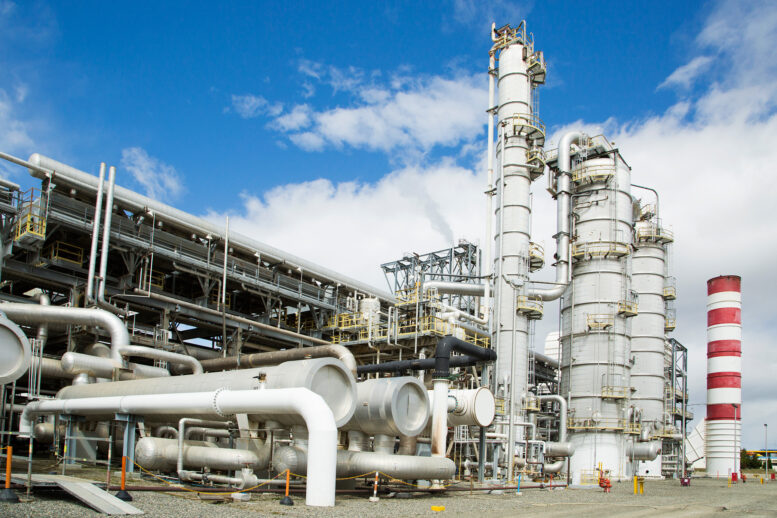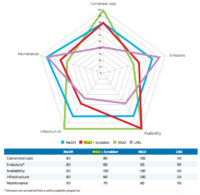Very large fuel tankers run on heavy fuel oil (HFO) mainly because of its low price but HFO emits a substantial amount of greenhouse gas (GHG). Cleaner ways of reducing emissions include shifting to alternative fuels like LNG, biogas, methanol, wind, hybrid-electric, fully electric, fuel cells, or by lowering speed.
The Paris Agreement and agreements within the IMO mandate that carbon dioxide (CO2) emissions from shipping must be reduced by 50% by 2050. The global shipping sector emits substantial CO2, Nitrogen Oxide (NOx), Sulphur Oxide (SOx), and particulate matter into the air.
AirClim of Sweden reports that through chemical reactions in the air, SOx and NOx are converted into very small airborne particles of sulphate and nitrate aerosols. These tiny airborne particles are linked to premature human deaths. The particles can get into the lungs and are small enough to pass through tissues and enter the blood. They can then trigger inflammations which eventually cause heart and lung failures. Ship emissions also have carcinogenic particles.
The International Organization for Standardization is in the process of developing a methanol marine fuel grade specification, and moving towards inclusion of low-flashpoint fuels into IMO’s IGF Code. The basic mandate of the IGF Code is to provide guidance for the arrangement, installation, control and monitoring of machinery, equipment, and systems using low flashpoint fuels, such as liquefied natural gas (LNG) and methanol, to minimize the risks to the ship, its crew, and the environment.
Methanol (CH3OH) is four parts hydrogen, one part oxygen, and one part carbon. It is mainly produced from natural gas by reforming the gas with steam, and then converting and distilling the resulting synthesized gas mixture to create pure methanol. It can also be made from coal, biomass or waste materials, or from CO2 in the atmosphere along with renewable hydrogen.
Chris Chatterton, Chief Operating Officer, Methanol Institute said: “Methanol is increasingly seen as one of the candidate fuels to be used in the decarbonization of shipping. It is already in use as marine fuel on tankers, bulkers, ferries and harbor craft. Its lower pollution and greenhouse gas emissions profile offers owners the opportunity to move towards IMO2030 compliance, whilst also gaining valuable knowledge towards IMO2050 ambitions.”
Douglas Raitt, Regional Advisory Services Manager, Lloyd’s Register, commented: “The maritime industry is sizing up many decarbonization options in its journey from low carbon to net zero. Methanol is among these and it offers a pathway that will enable owners to progressively lower their emissions’ profile while using conventional engine systems and technology to achieve net zero.”
Methanol, in contrast to petroleum-based fuels such as bunker oil and LNG, has only one type of molecule: CH3OH. Thus, when burned, methanol produces virtually no SOx or particulate matter, and emits very low levels of NOx. It has lower GHG emissions than conventional fuel and could help ship owners meet IMO2050.
To produce methanol using simple chemistry, water is split into hydrogen and oxygen with the aid of electricity from wind or hydro power. Hydrogen is then combined with CO2, from the paper industry, to form methanol. This electrofuel is called e-methanol, where e- stands for the electricity used in the production.
“Methanol is an excellent fuel, especially for ships. It’s a liquid at room temperature, which makes handling much easier than LNG. It is water-soluble, which means that any leaks are quickly diluted and broken down in natural processes. Its use results in very low emissions of NOx. Moreover, e-methanol is produced from renewable raw materials using green energy,” said Thomas Stenhede, Senior Technical Advisor for Liquid Wind, and founder.
When asked which ship fuels to look into for research, Selma Brynolf, scientist at the Department of Mechanics and Maritime Sciences, Chalmers University of Technology, said, “Recently, I’ve been concentrating on electrofuels, i.e., fuels that are made from hydrogen produced through the electrolysis of water and combined with CO2 or nitrogen. If we add CO2 to hydrogen, we can produce e.g., methane, methanol or diesel, and if we add nitrogen we can produce ammonia. Previously, we looked at LNG, methanol and biofuels where we studied production costs and conducted life cycle analyses. Next we’ll start taking a closer look at ammonia, pure hydrogen and electric drive.”
As to the advantages of methanol as a fuel, Brynolf said, “One advantage is that methanol is liquid at room temperature and normal pressures, unlike hydrogen and LNG. Methanol is a small molecule, and it takes relatively little energy to produce compared to diesel. Also, methanol has a lower risk of climate impact.”
As to the disadvantages of methanol as a fuel, Brynolf said, “Methanol contains less energy per unit mass than e.g. diesel, and this requires larger tanks. It is of course a toxic substance even when in contact with the skin, and must be handled appropriately, so special safety procedures are necessary when using methanol as a fuel. It shares a problem with all electrofuels – it’s expensive to produce. Electricity is necessary for the production of hydrogen gas and the actual methanol, and the equipment itself requires major investment, at least for the time being. It also calls for large quantities of CO2. Renewable sources of CO2 are of course preferable from a climate standpoint, but their availability is limited. Another alternative is to capture CO2 from the air, but that technology is expensive and not yet fully developed.”
Thomas Stenhede of Liquid Wind said, “Methanol is toxic, like any other fuel, and it will require different safety procedures. Methanol burns with an invisible flame. This is because it forms no particulates, which is fabulous in terms of the environment, but can be dangerous if you cannot locate the fire in an incident. So this will require training and new procedures.”
Another disadvantage is the energy content, which is only about half that of today’s ship fuels like HFO and MGO. “However, this is not a direct disadvantage on ships as they have plenty of space for fuel tanks and must anyway take on ballast. What’s more, the tanks can be made in any shape to fit the interior, unlike LNG tanks, which must be cylindrical,” said Stenhede.
The initial price of e-methanol will be about twice that of today’s low cost fossil fuels. However, Liquid Wind believes e-methanol will achieve parity with fossil fuels by 2030, Stenhede said. He believes methanol will increasingly be attractive as more stringent emission standards are imposed on the shipping sector.
Methanol’s emissions are negligible, and therefore definitely more environmentally friendly than Heavy Fuel Oil (HFO) or diesel. It is a clear, colorless liquid that quickly dissolves in water and biodegrades quickly. Thus, the negative environmental effect of a large methanol spill would be much lower than that of an equivalent oil spill.
Large quantities of methanol is available in most ports. A supply chain system can be developed, as methanol is one of the world’s most transported chemicals. And as a liquid fuel, methanol is the easier fuel in storing onboard ships as well as in distributing, compared with gas or electricity.
Methanol is now one of the top five chemical commodities shipped worldwide. Methanol requires only minor changes to the existing port terminal infrastructure and is already available for bunkering at over 88 of the world’s top 100 ports.
Methanol is well-suited for ships because it is a more efficient fuel yet less complicated to produce. There are ship engines that have used methanol. So far, large two-stroke engines for methanol are commercially available, but now a range of four-stroke engines are being developed to be powered by methanol.
Methanex reports that In 2016, Waterfront Shipping Company Ltd., Mitsui O.S.K. Lines Ltd., Marinvest/Skagerack Invest, and Westfal-Larsen Management welcomed the world’s first 7 new innovative, clean-burning, fuel-efficient ocean-going vessels to the sea. These seven 50,000 dead weight ton (DWT) vessels are built with the first-of-its kind MAN B&W ME-LGI 2-stroke dual fuel engine that can run on methanol, fuel oil, marine diesel oil, or gas oil. In 2018, Waterfront Shipping, Marinvest/Skagerack Invest, IINO Kaiun Kaisha, Ltd., Mitsui & Co., Ltd., and NYK Group announced their investment in another four dual-fuel vessels powered by the new second generation MAN dual fuel engines. These vessels were delivered in 2019, and have the ability to achieve Tier III NOx standards without after-treatment.
For methanol to become the dominant marine fuel of the future, the shipping industry will need to convert ship engines in a simple and cost-efficient way to run on methanol. New engines must preferably be developed and will need to do ship trials at sea. Nevertheless, the cost to convert vessels to run on methanol would be significantly less than what other alternative fuel conversions will cost, without the need for expensive exhaust gas after-treatment. Moreover, as a liquid fuel, only minor modifications are needed for existing storage and bunkering infrastructure to handle methanol. The cost of methanol also has to significantly drop to compete with LNG and MGO.
References:
- Bunkering Technical Reference on Methanol (July 2020), Lloyd’s Register (LR) and Methanol Institute (MI), https://3xxngg2wmai7100rss2cgkmj-wpengine.netdna-ssl.com/wp-content/uploads/2020/04/Introduction_to_Methanol_Bunkering___Technical_Reference_1.6_final.pdf .
- E-methanol -the future fuel?, Wallenius Sol, https://wallenius-sol.com/en/e-methanol-future-fuel.
- Methanol Could be a Climate Neutral Option for Shipping, IMO, https://imo.einnews.com/pr_news/529475412/methanol-could-be-a-climate-neutral-option-for-shipping?n=2&code=J1pWHa6B3LUV48RH&utm_source=NewsletterNews&utm_medium=email&utm_campaign=International+Maritime+Organization+News&utm_content=article.
- Air Pollution from Ships, Air Pollution and Climate Secretariat of Sweden, https://www.airclim.org/air-pollution-ships.
- About Methanol, Methanex, https://www.methanex.com/about-methanol/how-methanol-made#:~:text=About%20Methanol,-Overview&text=Methanol%20%E2%80%93%20CH3OH%20%E2%80%93%20is,mixture%20to%20create%20pure%20methanol.

